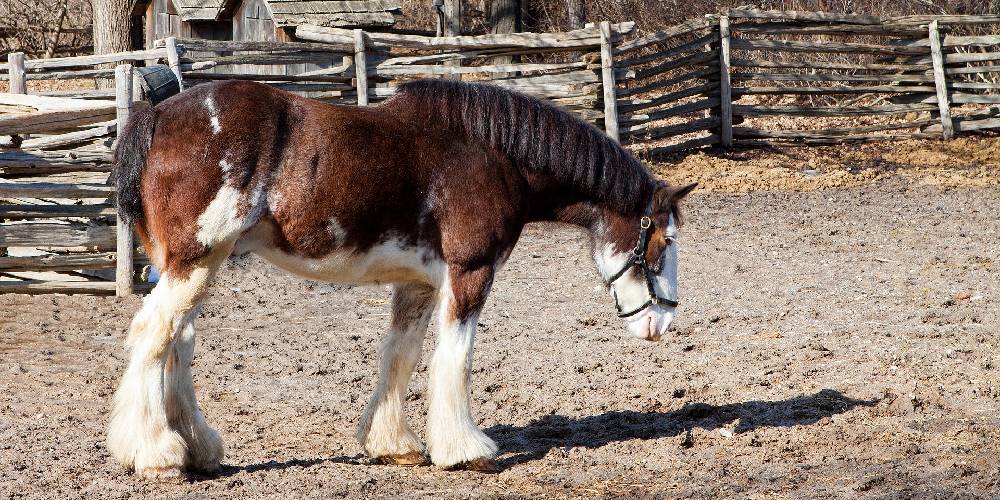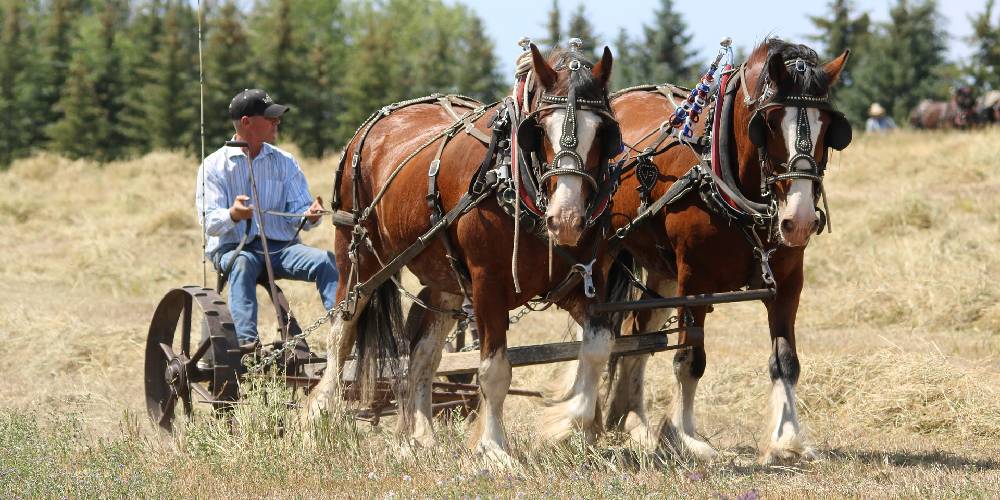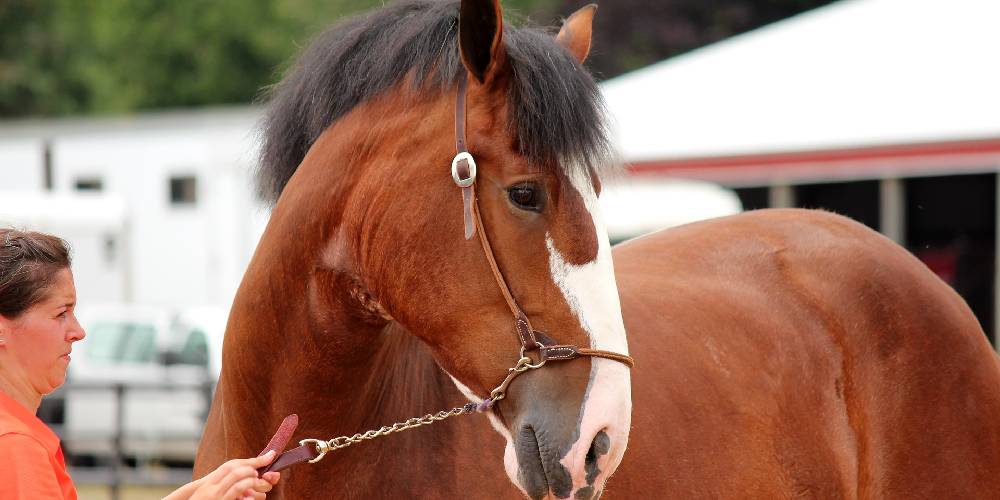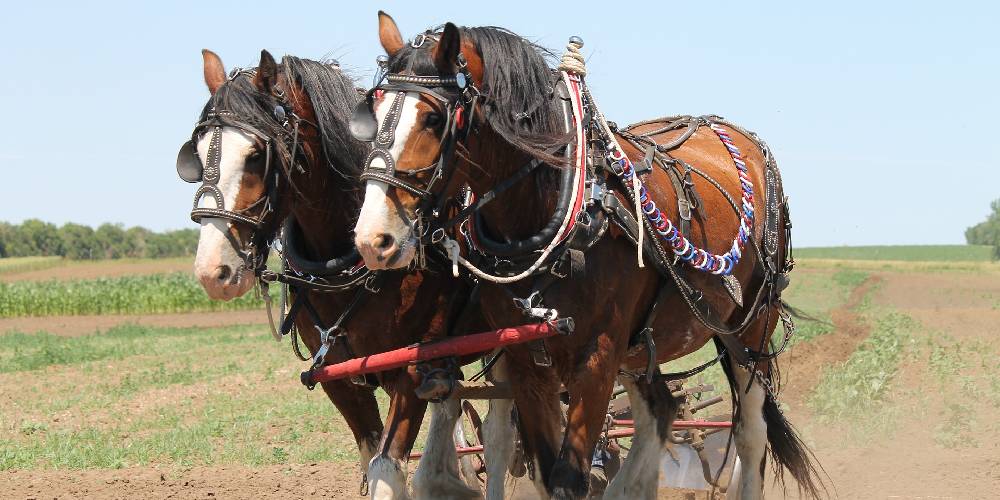Have you ever seen a Budweiser Superbowl commercial? This is partly what made the Clydesdale breed so famous. This massive draft breed is used by breweries like Budweiser all over the world for parades and demonstrations. These horses are also used for riding, pulling, driving, and in-hand show classes. The Clydesdale is a Scottish breed now seen all over the world and is only growing in popularity.
What Is A Clydesdale?
A Clydesdale is a coldblooded draft horse that originated in Scotland. These horses are known for their incredible height and amazing pulling ability. Clydesdales are huge horses that can stand between 17 and 19 hands high. Some are even known to stand over 20 hands high in some rare cases! Bay is the most common color to see these horses in and they usually will have four white stockings and a blaze when looking at the common face and leg markings. Clydesdales are popular all over the world for riding, pulling, and showing.
What Is The Average Height & Weight Of This Breed?
Clydesdales are one of the biggest horses in the world. These gigantic animals can stand between 17 and 19 hands high on average though some are known to reach over 20 hands high in height!
These horses, because they are heavy draft breeds, can weigh well over a ton. The average weight these horses can be falls between 1,800 and 2,300 pounds. The weight can vary depending on height, body condition, age, and gender.
What Colors Can The Clydesdale Be?

Bay is the most common color seen in the Clydesdale breed, and I have honestly not seen them come in any other color. These horses will sometimes be seen as sabino which is a coat pattern. Sabino horses have white legs and a white belly, but the rest of the body will remain the base color which in this case, is bay.
The History Of The Breed
The Clydesdale is a breed of horse that originated in the Clyde region of Scotland. This breed was developed in the mid-1700s and eventually replaced the use of the Shire Draft breed in Scotland.
There are several different breeds and types of horses that were added to the bloodline of these horses to create and improve the breed. these breeds and horses were:
- Belgian Draft Horses
- Flemish Great Horses
- Native Scottish Horses
- Shire Draft Horses
Clydesdales were created by Flemish, Native, and Belgian draft horses, but improved by Shire horses.
Because they originated in the region of Clyde, the early Clydesdales were referred to as Clydesman’s horses. The people of Clyde began to admire this breed for their strength and pulling power.
Clydesdales were used in the country of England for pulling coal after Shire blood was added to the line to improve muscle and bulk.
The three early influential stallions of this breed were Glancer, Broomfield Champion, and Clyde. Glancer was known for bringing great conformation and traits to the breed, Broomfield Champion is thought to be one of the founding stallions of the breed, and Clyde is thought to be the first modern day Clydesdale born.
How To Identify The Clydesdale

The Clydesdale can be identified by a number of characteristics. These are:
Height
This breed’s immense height can be a complete giveaway to what kind of horse they are. Clydesdales are so huge so just their size can be put at the top of most identifiable features.
Color
Bay, specifically blood bay is the most common color for Clydesdale horses to be seen in. It is rare that this breed would ever be seen in another color and those that do come in other colors might not even be considered purebred Clydesdales. Clydesdales are just big bay draft horses.
Markings
Large striking markings are what most of these horses carry. The most common markings these horses are seen with are stockings and blazes. A blaze is a huge, wide white stripe right down the middle of a horse’s face and stockings are tall white leg markings that cover most of the horse’s leg.
Sometimes, Clydesdales can be Sabino. This is where their legs and bellies are completely white while the rest of their body is, in this case, bay. Though some Clydesdales are Sabino, the most common leg markings are just stockings.
Head
These horses have large wide heads that sit nicely on their strong necks. Their heads appear to be thick and heavy but offer a kind expression.
Build
As you might have noticed from the weight of this horse (mentioned above) and from images you will see throughout this article, the Clydesdale is built heavily with dense muscling, powerful quarters, and strong legs. This is a key trait that these horses can be identified by. Knowing how to identify a draft breed by this trait can be important!
Eyes
The eyes of a Clydesdale are generally really soft and kind. I have never seen a Clydesdale with a mean or fiery look in its eye.
Personalities
I have heard that Clydesdales are pretty gentle giants, but at the same time I’ve heard stories that suggest something else. My farrier told me that Clydesdales know their size and take advantage of it. This farrier said that through working with these horses for a long time and having several clients with Clydesdales, he has learned that these horses are not afraid to be pushy or headstrong as they know their size.
Every horse has their own personality and every horse is different. Some Clydesdales may be pushy while others are mellow and responsive to their owners. It depends on the horse!
What Is The Clydesdale Good At & Used For?

Driving
Clydesdales make great driving horses and are most frequently seen being used to pull a carriage over anything else. These horses were bred to do hard labor such as pulling and driving carts and still today this is what they are used for.
Teamwork
These horses work great in teams and usually will be paired with multiple horses when pulling heavier loads such as coaches, or carriages.
Farmwork
Pulling a plow is another thing that these draft horses were bred to be used for. Thanks to their strength, the Clydesdale makes a great farm horse when it comes to doing all manner of tasks.
General Riding
Clydesdales were not bred to be ridden, but Clydesdales used for riding are becoming a more and more popular thing. Sometimes these horses will be shown in classes like dressage, but much of their riding career is spent outside of competition.
How Long Do Clydesdale Draft Horses Live?
Clydesdales actually have a pretty average lifespan for that of a draft horse. Usually, these horses live to be between 20 and 25 years of age, but many will surpass even that and live on into their late twenties and early thirties.
Fun Facts On Clydesdales

- Depending on their age, height, and workload, Clydesdale horses can eat between 30 and 50 pounds of hay per day as well as 2 to 10 pounds of grain on top of that. Lots of food is needed to fuel this gigantic animal!
- The average horse drinks around 10 to 15 gallons of water per day while the Clydesdale drinks a whopping 30!
- Clydesdales were once used to haul coal
- Though Clydesdales are the tallest breed of horse in the world, Belgians are bigger when it comes to weight and body mass.
- Clydesdales are so big that they often need to have larger trailers and larger stalls made for them to accommodate their huge size.
FAQs On This Breed
How much does a Clydesdale draft horse cost on average?
Depending on the age, size, gender, and level of training, Clydesdales can cost between $3,000 and $10,000 on average.
How fast can a Clydesdale horse run?
Because they are so heavy ans big in size, these horses are not fast movers at all. At a full gallop, the top speed of a Clydesdale is only around 20 miles per hour.
Is there a Clydesdale horse association or society?
Yes, the Clydesdale Horse Society was formed in the year 1877 and is still running today.

